A Convection-Permitting Regional Climate Simulation of Changes in Precipitation and Snowpack in a Warmer Climate over the Interior Western United States
Abstract
1. Introduction
2. Numerical Approach
2.1. IWUS Historical Climate Simulation
2.2. IWUS Future Climate Simulation
3. Results
3.1. Projected Change in Precipitation
3.2. Projected Change in Cold-Season Snow Ratio
3.3. Projected Change in Snowpack
4. Discussion
5. Conclusions
- Annual precipitation is projected to rise across the majority of the IWUS, with increases of up to 90 mm and percentage changes reaching as high as 18%. Winter precipitation is projected to increase across the domain, while spring and fall show regional variations, and summer precipitation is expected to decrease, particularly in the High Plains and southwestern areas.
- The projected increase in precipitation over the mountain ranges is largely driven by the heightened frequency of heavy to extreme precipitation events in a warmer climate. Precipitation is projected to increase at all elevations, though the magnitude of the change decreases with height, with smaller increases at higher mountain peaks. Seasonal patterns vary, with greater increases at higher elevations in winter, more pronounced increases at lower elevations in summer, and mixed responses in spring and fall, where lower elevations see precipitation increases or decreases depending on the region.
- While higher SRs are found in mountainous areas and lower SR values in valleys and the High Plains, the projected future climate indicates a decrease in SR across the entire domain, with a general percentage decrease of up to 30%. In all four subregions, SR are projected to decrease in the future, with the most significant reductions occurring at lower elevations.
- The snowpack is projected to decrease across most of the study domain, with the largest reductions occurring in the Montana Rockies and Greater Yellowstone, where decreases can reach up to 30%, although the overall change remains small relative to absolute SWE values.
- SWE is projected to decrease at nearly all elevations, but the largest reductions occur at higher elevations, particularly in the Wasatch Range and Colorado Rockies, while the Greater Yellowstone area shows a reversal of this trend at its highest elevations. The most significant reductions of SWE occur at the highest elevations in the Greater Yellowstone area, Wasatch Range, and Colorado Rockies, and there are similar reductions across all subgroups in the Montana Rockies.
- A timing index was defined to measure the shift in snowpack melt timing under future climate projections, revealing that snowpack melt is projected to occur earlier across all elevations, with changes ranging from 15 to 26 days.
Author Contributions
Funding
Institutional Review Board Statement
Informed Consent Statement
Data Availability Statement
Acknowledgments
Conflicts of Interest
References
- Milly, P.; Betancourt, J.; Falkenmark, M.; Hirsch, R.; Kundzewicz, Z.; Lettenmaier, D.; Stouffer, R. Stationarity is dead: Whither water management? Science 2008, 319, 573–574. [Google Scholar] [CrossRef]
- Luce, C.; Abatzoglou, J.; Holden, Z. The missing mountain water: Slower westerlies decrease orographic enhancement in the Pacific Northwest USA. Science 2013, 342, 1360–1364. [Google Scholar] [CrossRef]
- Ault, T.; Mankin, J.; Cook, B.; Smerdon, J. Relative impacts of mitigation, temperature, and precipitation on 21st-century megadrought risk in the American Southwest. Sci. Adv. 2016, 2, e1600873. [Google Scholar] [CrossRef]
- Barry, R.; Chorley, R. Atmosphere, Weather and Climate; Routledge: London, UK, 2009. [Google Scholar]
- Mote, P.; Hamlet, A.; Clark, M.; Lettenmaier, D. Declining mountain snowpack in western North America. Bull. Am. Meteorol. Soc. 2005, 86, 39–50. [Google Scholar] [CrossRef]
- Das, T.; Pierce, D.; Cayan, D.; Vano, J.; Lettenmaier, D. The importance of warm season warming to western US streamflow changes. Geophys. Res. Lett. 2011, L23403. [Google Scholar]
- Fu, G.; Barber, M.; Chen, S. Hydro-climatic variability and trends in Washington State for the last 50 years. Hydrol. Process. Int. J. 2010, 24, 866–878. [Google Scholar] [CrossRef]
- Udall, B.; Overpeck, J. The twenty-first century Colorado River hot drought and implications for the future. Water Resour. Res. 2017, 53, 2404–2418. [Google Scholar] [CrossRef]
- Woodhouse, C. A paleo perspective on hydroclimatic variability in the western United States. Aquat. Sci. 2004, 66, 346–356. [Google Scholar] [CrossRef]
- Wang, Y.; Geerts, B.; Liu, C. A 30-year convection-permitting regional climate simulation over the interior western United States. Part I: Validation. Int. J. Climatol. 2018, 38, 3684–3704. [Google Scholar] [CrossRef]
- Rasmussen, R.; Liu, C.; Ikeda, K.; Gochis, D.; Yates, D.; Chen, F.; Tewari, M.; Barlage, M.; Dudhia, J.; Yu, W. Others High-resolution coupled climate runoff simulations of seasonal snowfall over Colorado: A process study of current and warmer climate. J. Clim. 2011, 24, 3015–3048. [Google Scholar]
- Rasmussen, R.; Ikeda, K.; Liu, C.; Gochis, D.; Clark, M.; Dai, A.; Gutmann, E.; Dudhia, J.; Chen, F.; Barlage, M. Others Climate change impacts on the water balance of the Colorado headwaters: High-resolution regional climate model simulations. J. Hydrometeorol. 2014, 15, 1091–1116. [Google Scholar] [CrossRef]
- Wang, S.; Wang, Y. Improving probabilistic hydroclimatic projections through high-resolution convection-permitting climate modeling and Markov chain Monte Carlo simulations. Clim. Dyn. 2019, 53, 1613–1636. [Google Scholar] [CrossRef]
- Prein, A.; Langhans, W.; Fosser, G.; Ferrone, A.; Ban, N.; Goergen, K.; Keller, M.; Tölle, M.; Gutjahr, O.; Feser, F. Others A review on regional convection-permitting climate modeling: Demonstrations, prospects, and challenges. Rev. Geophys. 2015, 53, 323–361. [Google Scholar] [CrossRef]
- Liu, C.; Ikeda, K.; Rasmussen, R.; Barlage, M.; Newman, A.; Prein, A.; Chen, F.; Chen, L.; Clark, M.; Dai, A. Others Continental-scale convection-permitting modeling of the current and future climate of North America. Clim. Dyn. 2017, 49, 71–95. [Google Scholar] [CrossRef]
- Jing, X.; Geerts, B.; Wang, Y.; Liu, C. Ambient factors controlling the wintertime precipitation distribution across mountain ranges in the interior western United States. Part II: Changes in orographic precipitation distribution in a pseudo-global warming simulation. J. Appl. Meteorol. Climatol. 2019, 58, 695–715. [Google Scholar] [CrossRef]
- Skamarock, W.; Klemp, J.; Dudhia, J.; Gill, D.; Barker, D.; Duda, M.; Huang, X.; Wang, W.; Powers, J. Others A description of the advanced research WRF version 3. NCAR Tech. Note 2008, 475, 10–5065. [Google Scholar]
- Liu, C.; Ikeda, K.; Thompson, G.; Rasmussen, R.; Dudhia, J. High-resolution simulations of wintertime precipitation in the Colorado Headwaters region: Sensitivity to physics parameterizations. Mon. Weather Rev. 2011, 139, 3533–3553. [Google Scholar] [CrossRef]
- Li, Y.; Li, Z.; Zhang, Z.; Chen, L.; Kurkute, S.; Scaff, L.; Pan, X. High-resolution regional climate modeling and projection over western Canada using a weather research forecasting model with a pseudo-global warming approach. Hydrol. Earth Syst. Sci. 2019, 23, 4635–4659. [Google Scholar] [CrossRef]
- Newman, A.; Monaghan, A.; Clark, M.; Ikeda, K.; Xue, L.; Gutmann, E.; Arnold, J. Hydroclimatic changes in Alaska portrayed by a high-resolution regional climate simulation. Clim. Change 2021, 164, 17. [Google Scholar] [CrossRef]
- Jing, X.; Geerts, B.; Wang, Y.; Liu, C. Evaluating seasonal orographic precipitation in the interior western United States using gauge data, gridded precipitation estimates, and a regional climate simulation. J. Hydrometeorol. 2017, 18, 2541–2558. [Google Scholar] [CrossRef]
- Saha, S.; Moorthi, S.; Pan, H.; Wu, X.; Wang, J.; Nadiga, S.; Tripp, P.; Kistler, R.; Woollen, J.; Behringer, D. Others The NCEP climate forecast system reanalysis. Bull. Am. Meteorol. Soc. 2010, 91, 1015–1058. [Google Scholar] [CrossRef]
- Thompson, G.; Field, P.; Rasmussen, R.; Hall, W. Explicit forecasts of winter precipitation using an improved bulk microphysics scheme. Part II: Implementation of a new snow parameterization. Mon. Weather Rev. 2008, 136, 5095–5115. [Google Scholar] [CrossRef]
- Iacono, M.; Delamere, J.; Mlawer, E.; Shephard, M.; Clough, S.; Collins, W. Radiative forcing by long-lived greenhouse gases: Calculations with the AER radiative transfer models. J. Geophys. Res. Atmos. 2008, 113, D13103. [Google Scholar] [CrossRef]
- Hong, S.; Pan, H. Nonlocal boundary layer vertical diffusion in a medium-range forecast model. Mon. Weather Rev. 1996, 124, 2322–2339. [Google Scholar] [CrossRef]
- Jiménez, P.; Dudhia, J.; González-Rouco, J.; Navarro, J.; Montávez, J.; García-Bustamante, E. A revised scheme for the WRF surface layer formulation. Mon. Weather Rev. 2012, 140, 898–918. [Google Scholar] [CrossRef]
- Niu, G.; Yang, Z.; Mitchell, K.; Chen, F.; Ek, M.; Barlage, M.; Kumar, A.; Manning, K.; Niyogi, D.; Rosero, E. Others The community Noah land surface model with multiparameterization options (Noah-MP): 1. Model description and evaluation with local-scale measurements. J. Geophys. Res. Atmos. 2011, 116, D12109. [Google Scholar] [CrossRef]
- Yang, Z.; Niu, G.; Mitchell, K.; Chen, F.; Ek, M.; Barlage, M.; Longuevergne, L.; Manning, K.; Niyogi, D.; Tewari, M. Others The community Noah land surface model with multiparameterization options (Noah-MP): 2. Evaluation over global river basins. J. Geophys. Res. Atmos. 2011, 116, D12110. [Google Scholar] [CrossRef]
- Serreze, M.; Clark, M.; Armstrong, R.; McGinnis, D.; Pulwarty, R. Characteristics of the western United States snowpack from snowpack telemetry (SNOTEL) data. Water Resour. Res. 1999, 35, 2145–2160. [Google Scholar] [CrossRef]
- Daly, C.; Neilson, R.; Phillips, D. A statistical-topographic model for mapping climatological precipitation over mountainous terrain. J. Appl. Meteorol. Climatol. 1994, 33, 140–158. [Google Scholar] [CrossRef]
- Schär, C.; Frei, C.; Lüthi, D.; Davies, H. Surrogate climate-change scenarios for regional climate models. Geophys. Res. Lett. 1996, 23, 669–672. [Google Scholar] [CrossRef]
- Eidhammer, T.; Grubišić, V.; Rasmussen, R.; Ikdea, K. Winter precipitation efficiency of mountain ranges in the Colorado Rockies under climate change. J. Geophys. Res. Atmos. 2018, 123, 2573–2590. [Google Scholar] [CrossRef]
- Hurrell, J.; Visbeck, M.; Pirani, P. WCRP coupled model intercomparison project-phase 5-CMIP5. Clivar Exch. 2011, 16, 1–52. [Google Scholar]
- Pachauri, R.; Allen, M.; Barros, V.; Broome, J.; Cramer, W.; Christ, R.; Church, J.; Clarke, L.; Dahe, Q.; Dasgupta, P. Others Climate change 2014: Synthesis Report. Contribution of Working Groups I, II and III to the Fifth Assessment Report of the Intergovernmental Panel on Climate Change; IPCC: Hayama, Japan, 2014. [Google Scholar]
- Jennings, K.; Winchell, T.; Livneh, B.; Molotch, N. Spatial variation of the rain–snow temperature threshold across the Northern Hemisphere. Nat. Commun. 2018, 9, 1148. [Google Scholar] [CrossRef] [PubMed]
- Barnett, T.; Adam, J.; Lettenmaier, D. Potential impacts of a warming climate on water availability in snow-dominated regions. Nature 2005, 438, 303–309. [Google Scholar] [CrossRef] [PubMed]
- Cayan, D. Interannual climate variability and snowpack in the western United States. J. Clim. 1996, 9, 928–948. [Google Scholar] [CrossRef]
- Hamlet, A.; Lettenmaier, D. Effects of 20th century warming and climate variability on flood risk in the western US. Water Resour. Res. 2007, 43, W06427. [Google Scholar] [CrossRef]
- Mote, P.; Salathé, E., Jr. Future climate in the Pacific Northwest. Clim. Change 2010, 102, 29–50. [Google Scholar] [CrossRef]
- Georgakakos, A.; Fleming, P.; Dettinger, M.; Peters-Lidard, C.; Richmond, T.; Reckhow, K.; White, K.; Yates, D.C. 3: Water Resources. In Climate Change Impacts in the United States: The Third National Climate Assessment; Melillo, J.M., Richmond, T.C., Yohe, G.W., Eds.; U.S. Global Change Research Program: Washington, DC, USA, 2014; pp. 69–112. [Google Scholar]
- Viviroli, D.; Archer, D.; Buytaert, W.; Fowler, H.; Greenwood, G.; Hamlet, A.; Huang, Y.; Koboltschnig, G.; Litaor, M.; López-Moreno, J. Others Climate change and mountain water resources: Overview and recommendations for research, management and policy. Hydrol. Earth Syst. Sci. 2011, 15, 471–504. [Google Scholar] [CrossRef]
- Hausfather, Z.; Peters, G. Emissions–the ‘business as usual’ story is misleading. Nature 2020, 577, 618–620. [Google Scholar] [CrossRef]
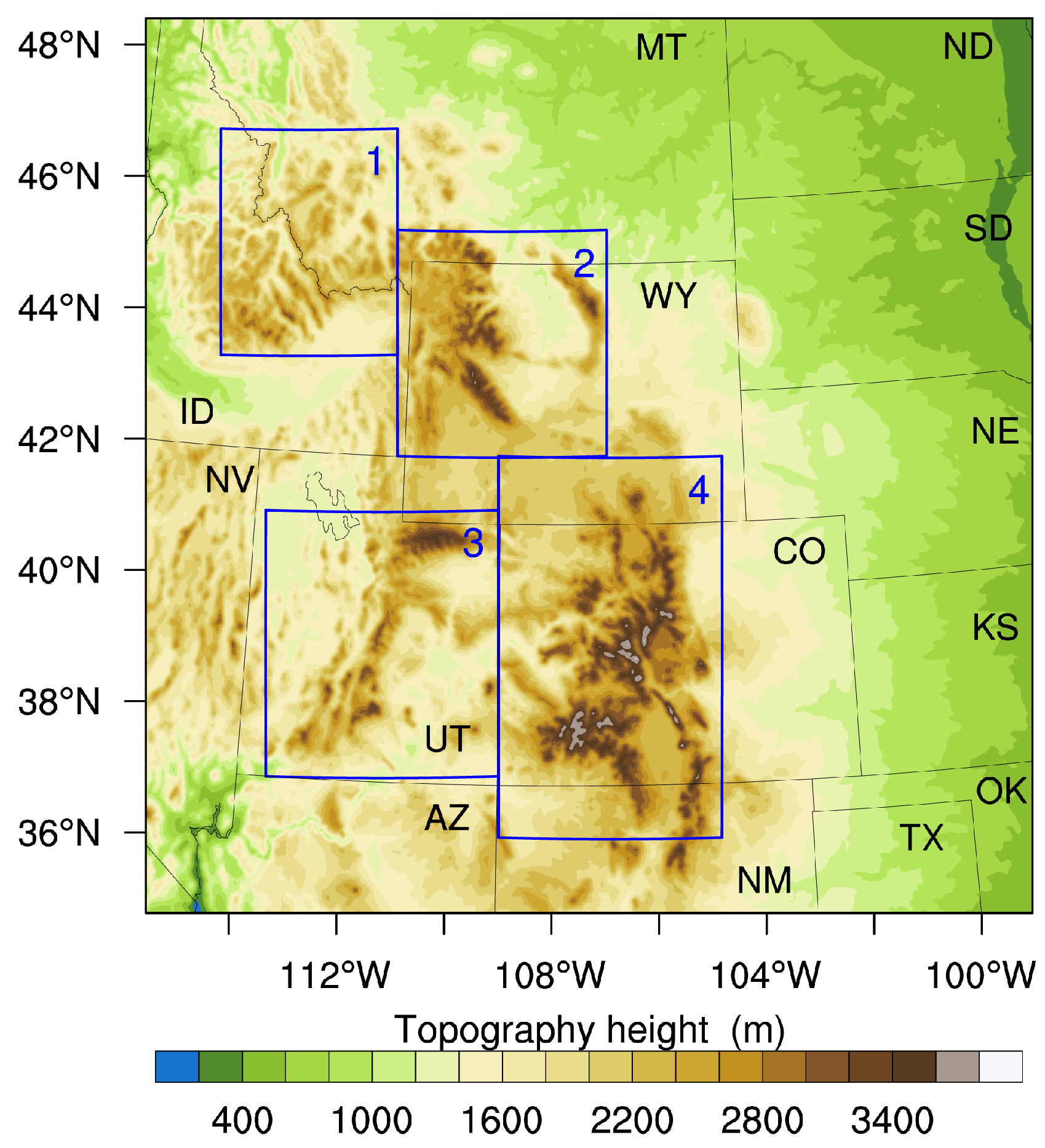
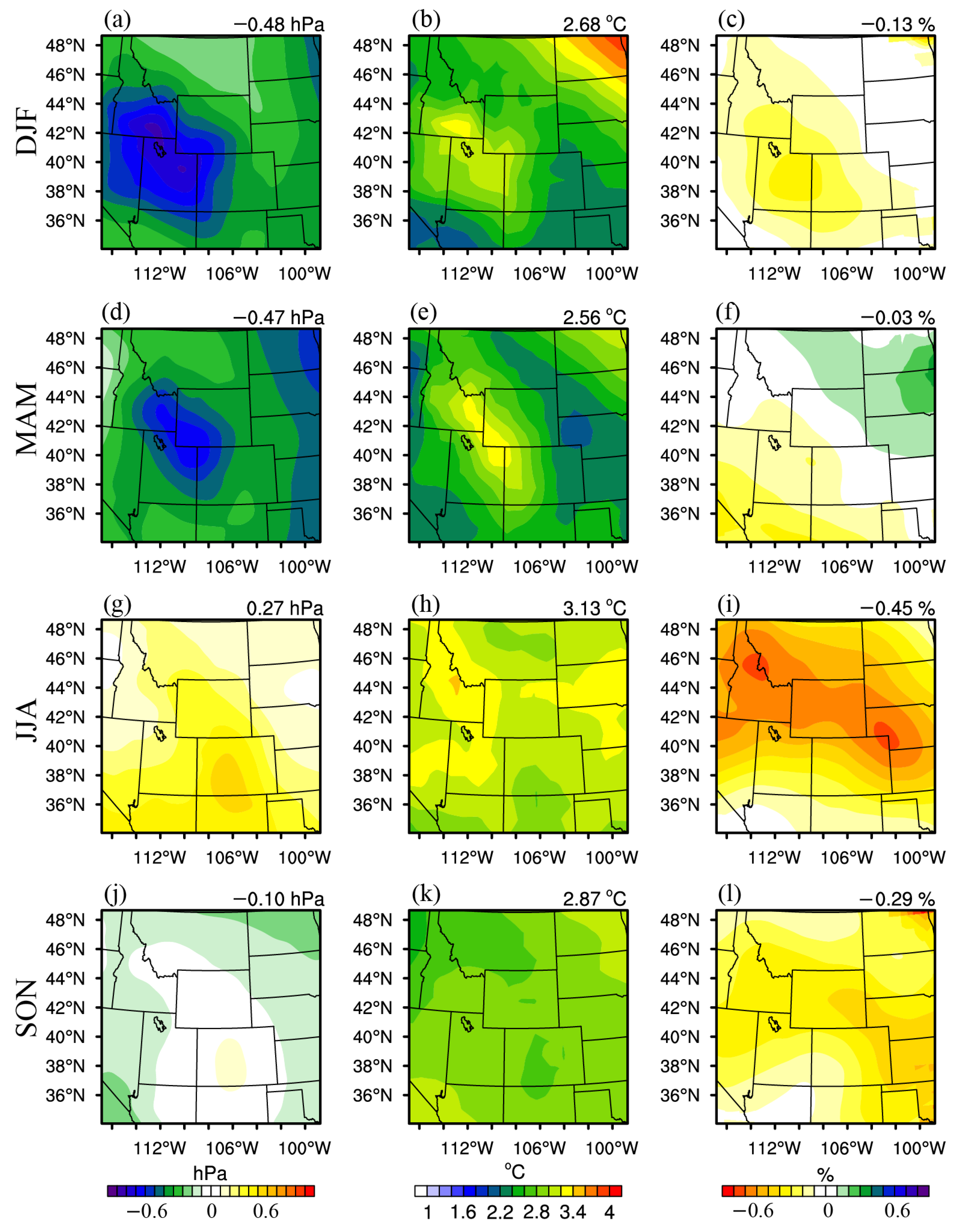
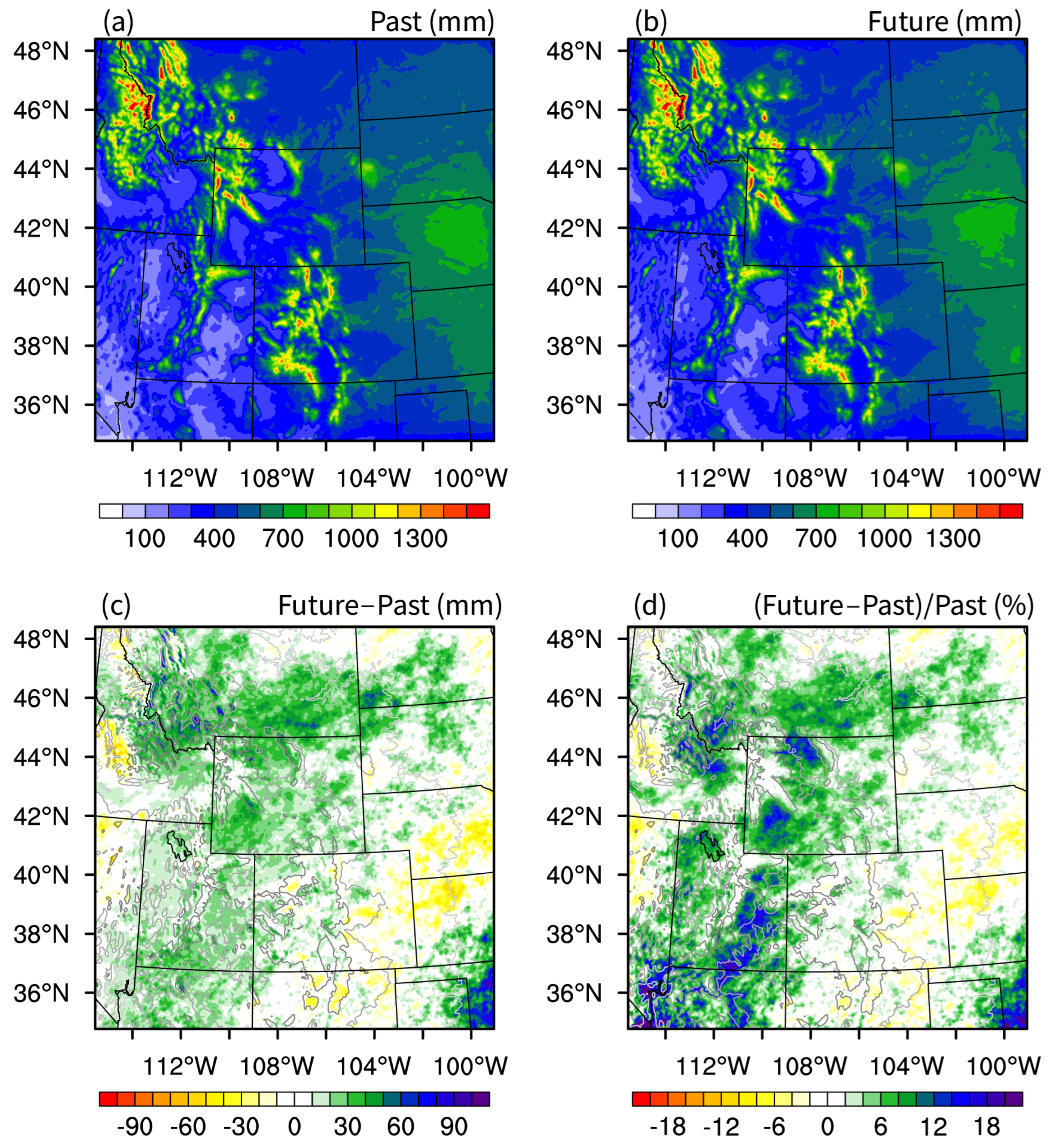
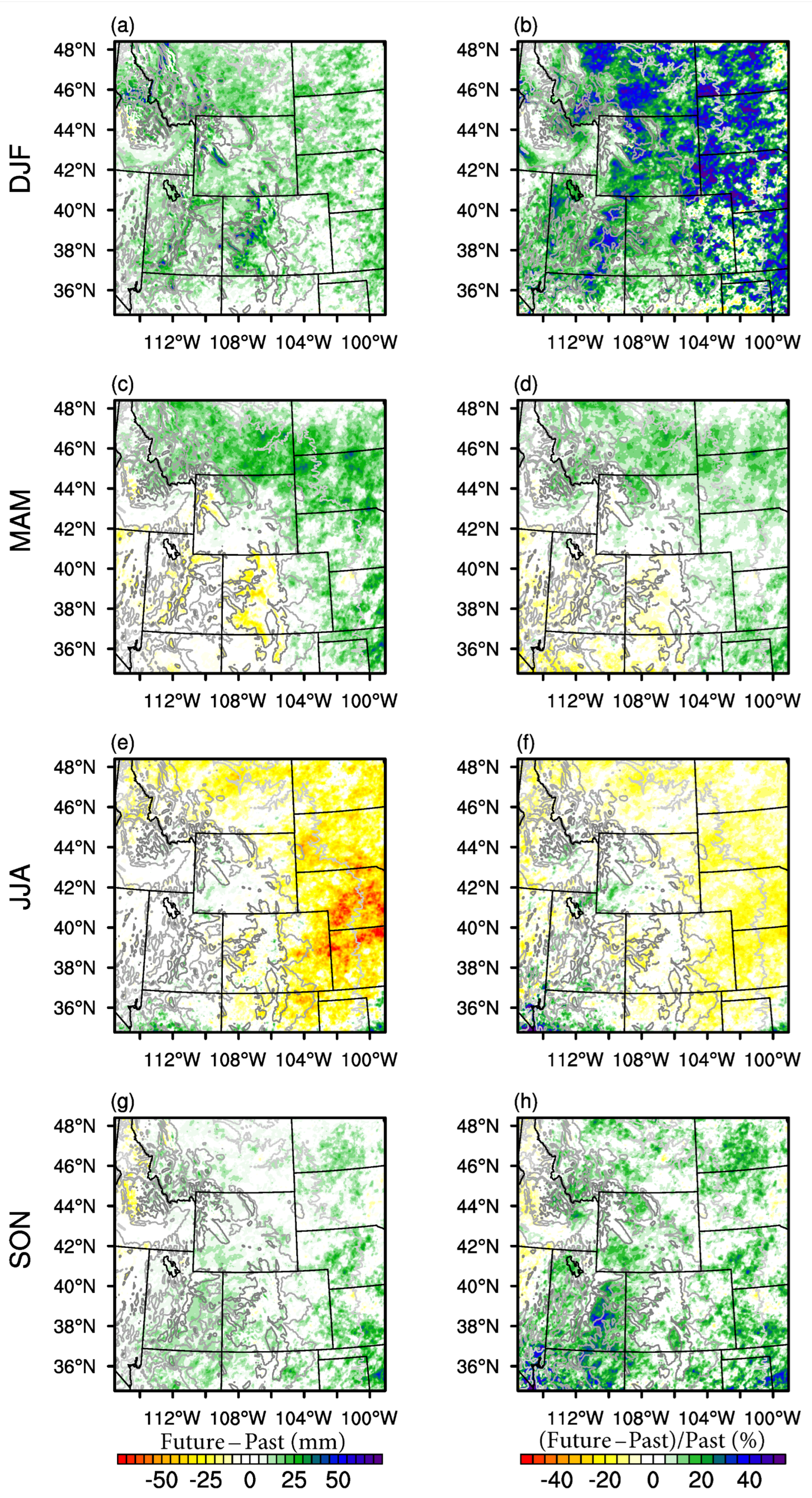
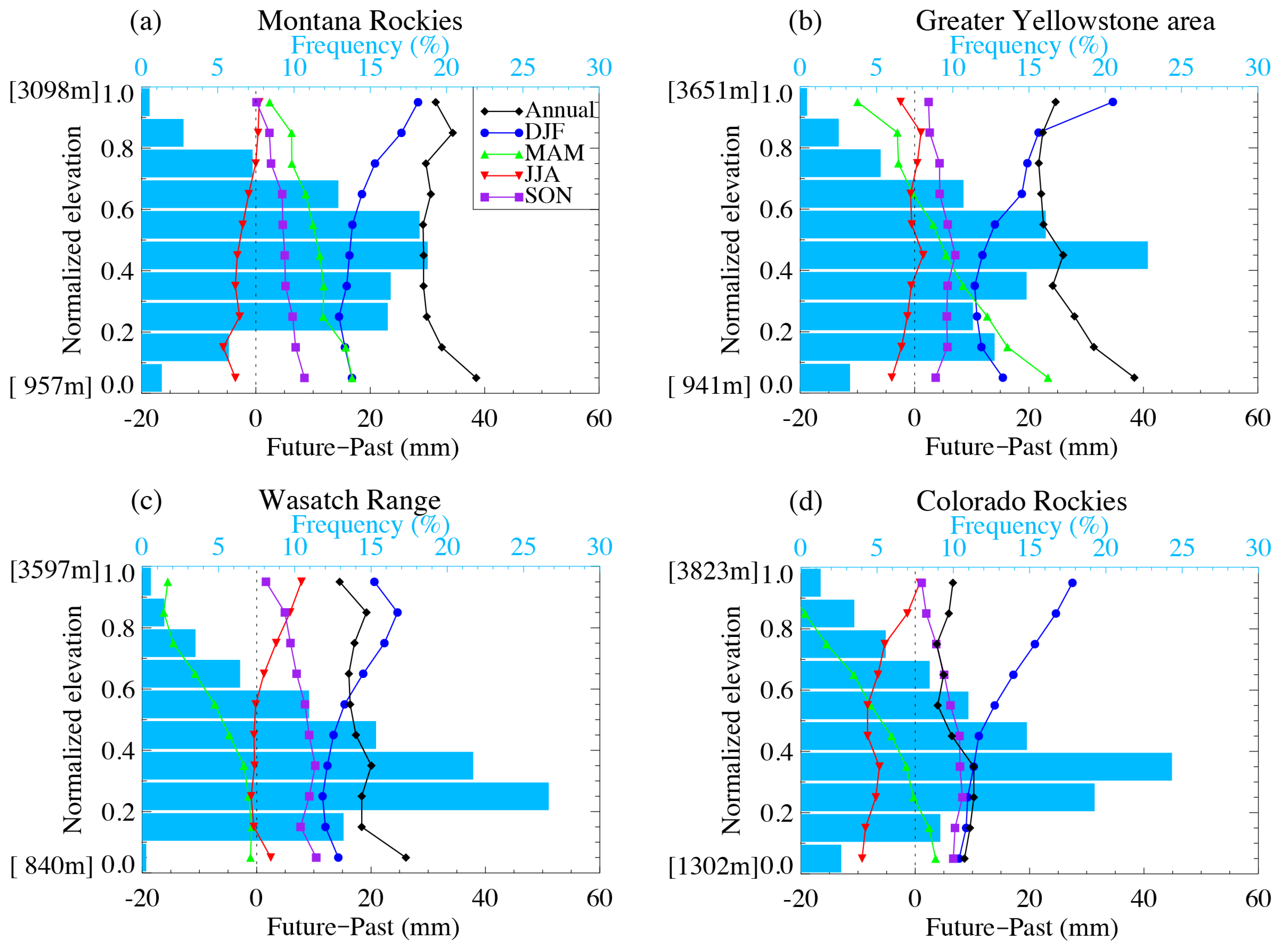
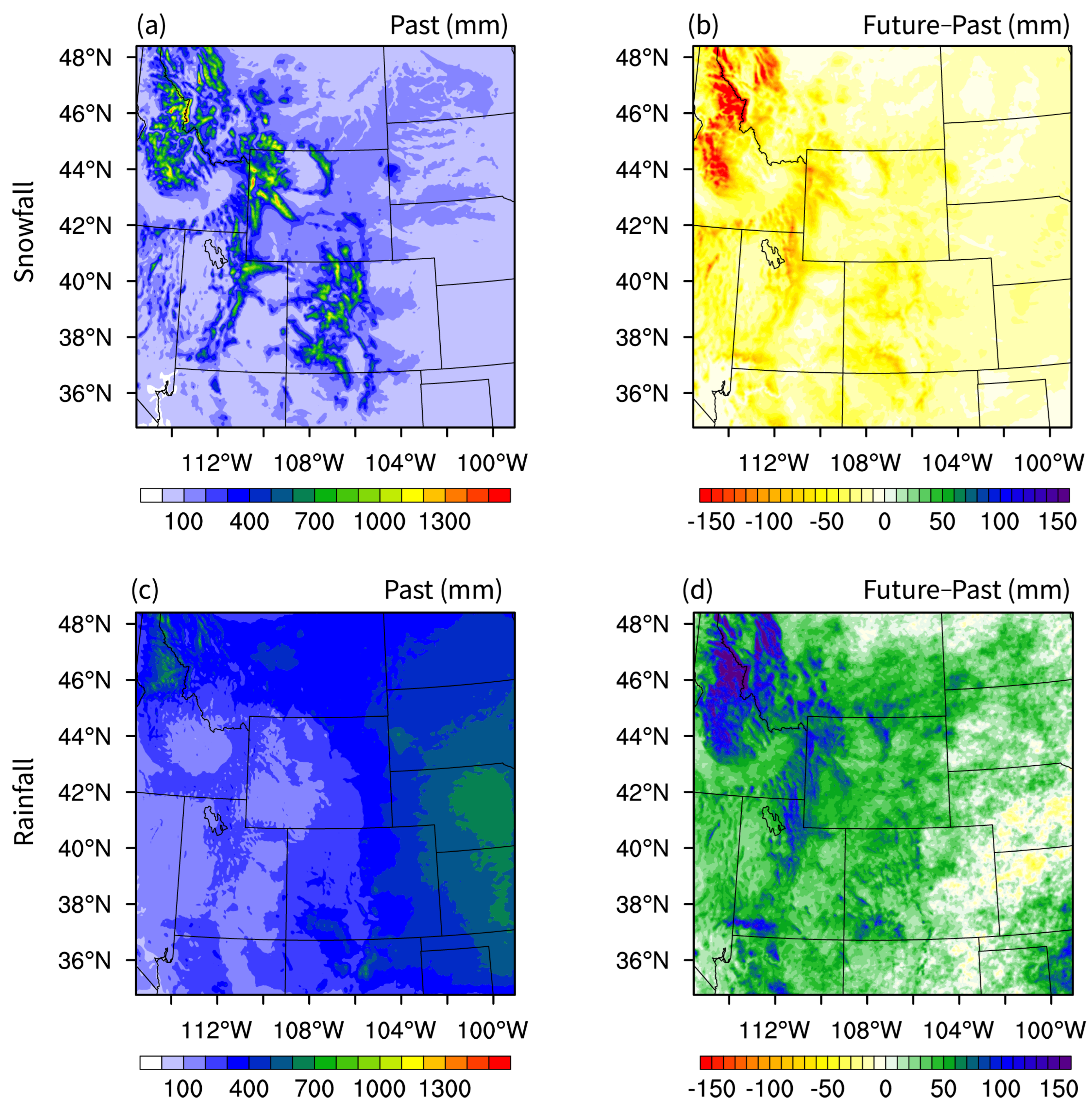

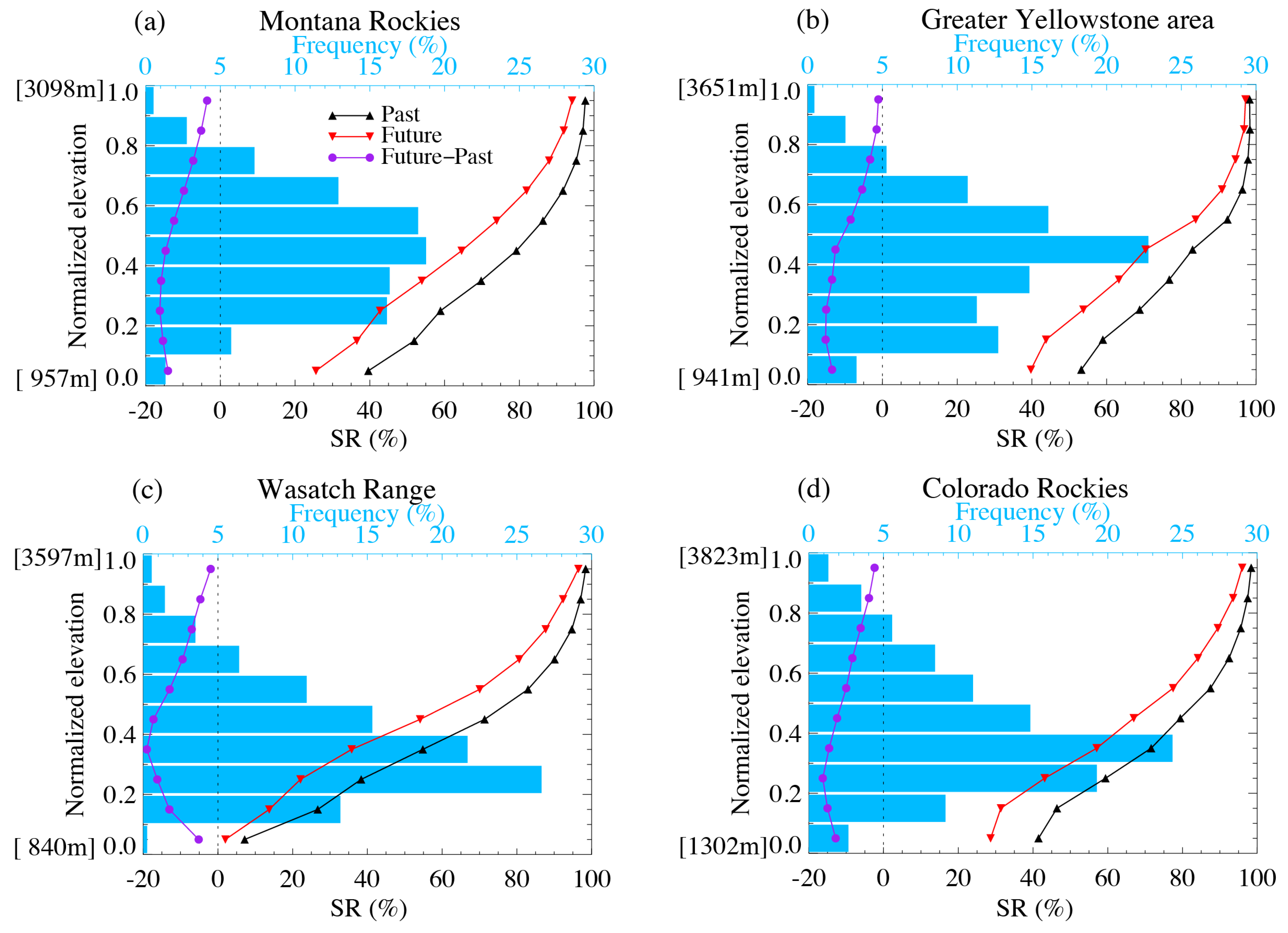



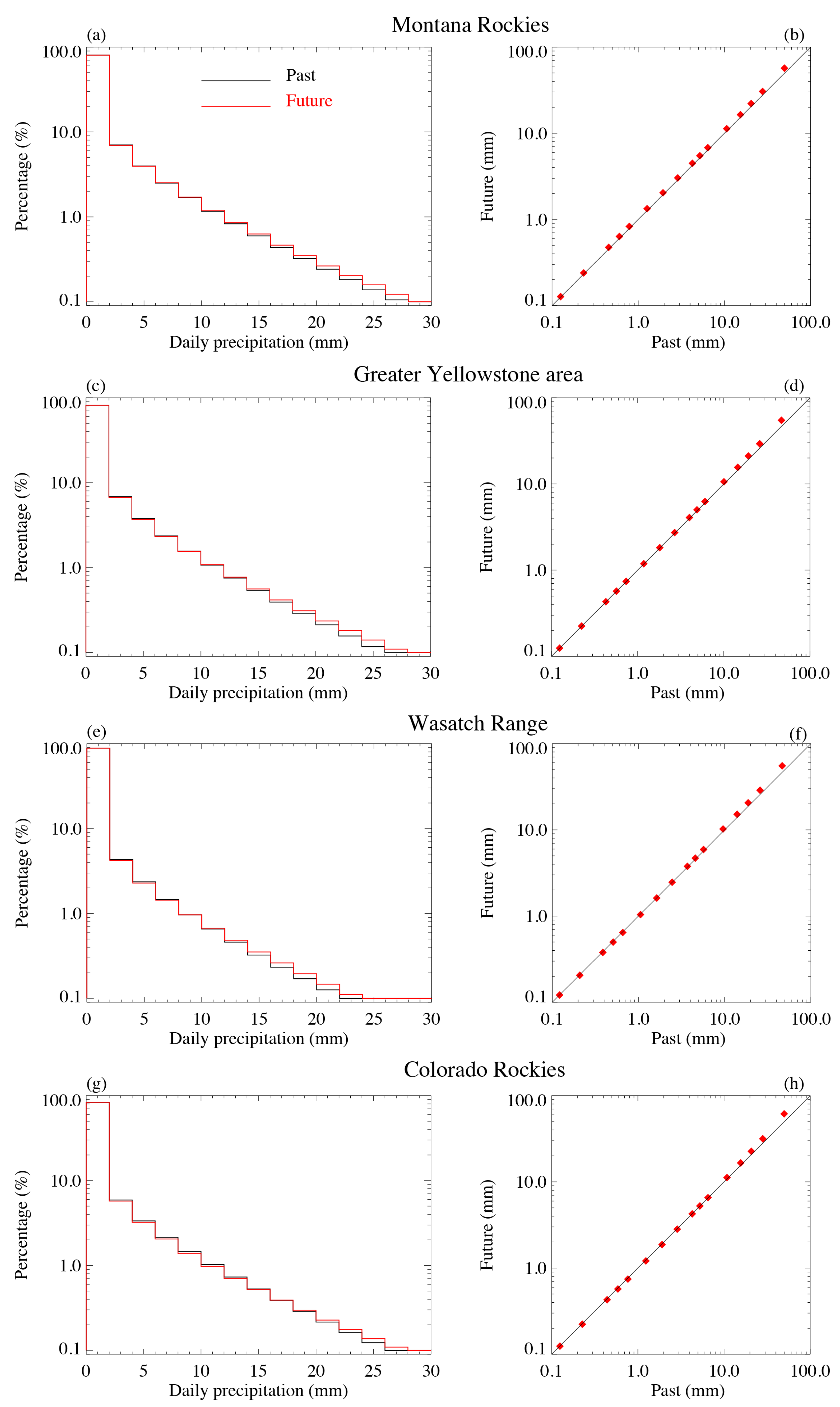
| WRF Physics | Parameterization Schemes | References |
|---|---|---|
| Microphysics | Thompson scheme | [23] |
| Radiation | Rapid Radiative Transfer Model (RRTMG) | [24] |
| Planetary boundary layer | Yonsei University (YSU) scheme | [25] |
| Surface layer | Revised Monin–Obukhov scheme | [26] |
| Land surface | Noah-MP scheme | [27,28] |
| CMIP5 I. D. | Atmospheric Grid Spacing (°) | Ensemble Members Used | |
|---|---|---|---|
| Latitude | Longitude | ||
| ACCESS1.3 | 1.25 | 1.875 | 1 (1) |
| CCSM4 | 0.94 | 1.25 | 3 (1, 2, 6) |
| CESM1-CAM5 | 0.94 | 1.25 | 3 (1, 2, 3) |
| CNRM-CM5 | 1.40 | 1.41 | 3 (2, 4, 6) |
| CSIRO-Mk3.6.0 | 1.87 | 1.88 | 3 (1, 2, 3) |
| GFDL-CM3 | 2.0 | 2.5 | 1 (1) |
| GFDL-ESM2M | 1.52 | 2.5 | 1 (1) |
| GISS-E2-H | 2.0 | 2.5 | 2 (1, 2) |
| HadGEM2-CC | 1.2 | 1.875 | 2 (2, 3) |
| HadGEM2-ES | 1.25 | 1.875 | 2 (2, 3) |
| INM-CM4 | 1.5 | 2.0 | 1 (1) |
| IPSL-CM5A-MR | 1.27 | 2.50 | 1 (1) |
| MIROC5 | 1.40 | 1.41 | 3 (1, 2, 3) |
| MIROC-ESM | 2.79 | 2.81 | 1 (1) |
| MRI-CGCM3 | 1.12 | 1.12 | 1 (1) |
| Montana Rockies | Greater Yellowstone Area | Wasatch Range | Colorado Rockies | ||
|---|---|---|---|---|---|
| DJF | Future − Current (mm) | 17.0 | 13.5 | 13.6 | 12.3 |
| Percent Change (%) | 15.2 | 16.9 | 17.9 | 13.4 | |
| MAM | Future − Current (mm) | 10.6 | 7.0 | −4.0 | −4.3 |
| Percent Change (%) | 6.6 | 4.9 | −2.6 | −2.5 | |
| JJA | Future − Current (mm) | −2.6 | −0.4 | −0.1 | −6.9 |
| Percent Change (%) | −1.1 | −0.4 | −0.3 | −4.0 | |
| SON | Future − Current (mm) | 5.0 | 5.7 | 8.8 | 6.8 |
| Percent Change (%) | 6.6 | 6.5 | 13.5 | 7.1 |
| Montana Rockies | Greater Yellowstone Area | Wasatch Range | Colorado Rockies | ||
|---|---|---|---|---|---|
| Light precipitation (0.1–4 mm) | Past | 68.45% | 70.06% | 71.88% | 68.35% |
| Future | 67.10% | 69.54% | 71.36% | 68.19% | |
| Future − Past | −1.35% | −0.52% | −0.52% | −0.16% | |
| Medium precipitation (4–14 mm) | Past | 25.50% | 24.54% | 23.15% | 25.38% |
| Future | 26.03% | 24.28% | 22.78% | 24.91% | |
| Future − Past | 0.53% | −0.26% | −0.37% | −0.47% | |
| Heavy precipitation (>14 mm) | Current | 6.06% | 5.40% | 4.96% | 6.27% |
| Future | 6.87% | 6.18% | 5.85% | 6.91% | |
| Future − Past | 0.81% | 0.78% | 0.89% | 0.64% |
Disclaimer/Publisher’s Note: The statements, opinions and data contained in all publications are solely those of the individual author(s) and contributor(s) and not of MDPI and/or the editor(s). MDPI and/or the editor(s) disclaim responsibility for any injury to people or property resulting from any ideas, methods, instructions or products referred to in the content. |
© 2025 by the authors. Licensee MDPI, Basel, Switzerland. This article is an open access article distributed under the terms and conditions of the Creative Commons Attribution (CC BY) license (https://creativecommons.org/licenses/by/4.0/).
Share and Cite
Wang, Y.; Geerts, B.; Liu, C.; Jing, X. A Convection-Permitting Regional Climate Simulation of Changes in Precipitation and Snowpack in a Warmer Climate over the Interior Western United States. Climate 2025, 13, 46. https://doi.org/10.3390/cli13030046
Wang Y, Geerts B, Liu C, Jing X. A Convection-Permitting Regional Climate Simulation of Changes in Precipitation and Snowpack in a Warmer Climate over the Interior Western United States. Climate. 2025; 13(3):46. https://doi.org/10.3390/cli13030046
Chicago/Turabian StyleWang, Yonggang, Bart Geerts, Changhai Liu, and Xiaoqin Jing. 2025. "A Convection-Permitting Regional Climate Simulation of Changes in Precipitation and Snowpack in a Warmer Climate over the Interior Western United States" Climate 13, no. 3: 46. https://doi.org/10.3390/cli13030046
APA StyleWang, Y., Geerts, B., Liu, C., & Jing, X. (2025). A Convection-Permitting Regional Climate Simulation of Changes in Precipitation and Snowpack in a Warmer Climate over the Interior Western United States. Climate, 13(3), 46. https://doi.org/10.3390/cli13030046





